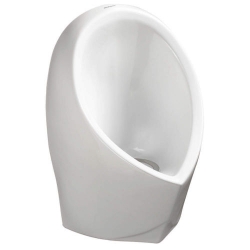
Acceptance of waterless urinals and the number of installations were growing well before the current California drought. That’s mostly due to improvements in the technologies, making them more pleasant to use and easier and far less expensive to keep working properly. And today they’re pretty much a necessity in Southern California where water conservation is a top priority.
We’re NOT talking porta-potty technology here! Designs have been continually improved and refined for some 1/4 century, starting with companies right here in San Diego in the early 1990s. Just 5 years ago there was still some resistance to their use, but with proper maintenance they’re now widely accepted.
Advantages of Waterless Urinals
Waterless urinals save water. No surprise there. But just how much may surprise you.
Water Conservation
As much as 20% of the world’s potable water is simply flushed down the drain. On average in the United States, a no-flush urinal in a commercial restroom saves some 20 to 45 thousand gallons of water a year, per urinal. For an office building with 120 men, upgrading from older urinals to waterless urinals would save 1/4 million gallons of water per year! That’s a huge water conservation impact.
Now in California we’re well below the national range of 1-2 gallons of water per flush for all existing urinals but we do, and will continue to, experience limited water supplies. Besides water bills, upgrading to this new technology will save you money on sewer charges and help protect you from high-use penalties. In many locations waterless urinals are a requirement in new construction and remodels.
Additional Benefits of Waterless Urinals
Health experts have long known that urinals are more sanitary than toilets, with no “flushing turbulence” to create airborne bacteria. Urine itself is sterile, and a waterless urinal should have far less moisture exposed to promote microbe growth.
You can also benefit from additional cost savings, with no flush-valve repairs, no deodorizers, no overflows or water leaks, and reduced vandalism. For new construction, you’ll have lower water and sewer connection fees, and both new installations and upgrades may qualify for rebates.
How Waterless Urinals Work
Although getting all the aspects of a design just right is difficult, the principle of operation is straightforward and pretty much like the U trap under sinks.
Urine flows by gravity into a trap with a sealing liquid, then down the regular drain line. That liquid is a specially formulated oil that forms a barrier that keeps sewer gases and odors from entering the restroom. It’s simple… oil is lighter than water so it floats on top as urine sinks and flows through. The trick is minimizing splashing and keeping fluid flows from disturbing that barrier layer. Some designs use a replaceable cartridge instead.
Proper design, installation, and maintenance are critical in avoiding the perceived drawbacks of this new technology. The pros at ASAP Drain Guys & Plumbing will be happy to advise you concerning the best make and model for your particular needs and criteria.
No Maintenance Problems!
All urinals require regular wipe-down and cleaning, and waterless urinals have no hard water or rust build up issues to deal with. Properly maintained, they should have no odor or cleanliness issues.
It is necessary to replace the sealing liquid, usually about every 1,500 uses. That’s simply pouring down a bucket of hot water then pouring in a few ounces of liquid. All in all that takes about 1/2 minute. The trap also collects sediments, and needs an very inexpensive replacement 2 to 4 times per year. It takes well under 5 minutes.
Overall operating costs have been estimated at $1 per 1,000 uses. That’s a dramatic savings over standard urinals.
Where They Work
No-flush urinals are now well accepted in a wide range of commercial, industrial, institutional, and military situations. These include airports, camps, colleges, hospitals, offices, parks, playgrounds, recreational facilities, rest stops, schools, and sports facilities among others.
Installing a new waterless urinal takes less time than standard units, typically 1/2 hour or less. Simple retrofits generally take an hour or less, but lowering the drain rough-in to meet new requirements may add another hour or so.
Doing It Right
So now you understand one of the best water conservation measures around.
Not all plumbers have the know-how and experience needed for the proper selection and installation of waterless urinals. Besides doing the job right, there are special codes, including specific ADA requirements. You can count on ASAP to guide you through the process of selection, installation, and maintenance.
Your options go beyond utilitarian basics. No-flush urinals are available in light-weight high-performance composites as well as vitreous china, and in a surprising variety of colors and styles. They’ve made people at the New York Mets Citi Field Stadium happy, so may sure please you and your building’s occupants.


